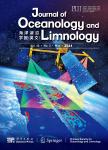Distribution of benthic macrofaunal communities in intertidal flat under hydrodynamic influence:a case study of Jiangsu coast,East China
作者机构:School of Geography and Ocean ScienceNanjing UniversityNanjing 210023China State Key Laboratory of Estuarine and Coastal ResearchEast China Normal UniversityShanghai 200241China School of Marine Science and EngineeringNanjing Normal UniversityNanjing 210046China
出 版 物:《Journal of Oceanology and Limnology》 (海洋湖沼学报(英文))
年 卷 期:2023年第41卷第3期
页 面:1024-1038页
核心收录:
基 金:Supported by the National Natural Science Foundation of China(Nos.41576154,41625021) the National Key Basic Research Program of China(No.2013CB956500)
主 题:macrofaunal communities hydrodynamic process inter-tidal ecosystem sedimentation tidal flat Jiangsu coast
摘 要:To identify the distribution pattern of macrofaunal assemblages of the Dafeng intertidal flats in response to hydrodynamic and sediment dynamic processes in the northern Jiangsu coast,East China,macrofauna sampling and hydrodynamic observations were carried out simultaneously across the mud flat,mixed mud-sand flat,and silt-sand flat of the intertidal zone in June *** show that there was a clear zonal distribution pattern of the macrofaunal communities,as is controlled by local hydrological and sedimentary *** component analysis(PCA)revealed three types of intertidal area in terms of hydrological and surficial sediment ***,three distinct groups of the macrofaunal communities,i.e.,mud flat,mix mud-sand,and silt-sand groups,were recognized at similarity level of 24%based on the CLUSTER analysis in similarity profile(SIMPROF)*** analysis upon best variables stepwise search(BVSTEP)indicated the importance of the hydrodynamics(e.g.,water temperature and salinity,tidal duration,flow speed,suspended sediment concentration,and wave height)in the differentiation of macrofaunal communities with different taxonomic classes over the intertidal ***,macrofaunal assemblages,similar to hydrology and surficial sediment,have a unique zonation ***-sized deposit feeders adapt better to low energy environments,thus dominated the upper part of the intertidal flat,whilst the heavy and large-sized filter feeders and deposit feeders were dominant over the middle and lower *** hydrodynamic and sediment processes cause biota-niche separation,which affected the biological processes across the intertidal flat.



